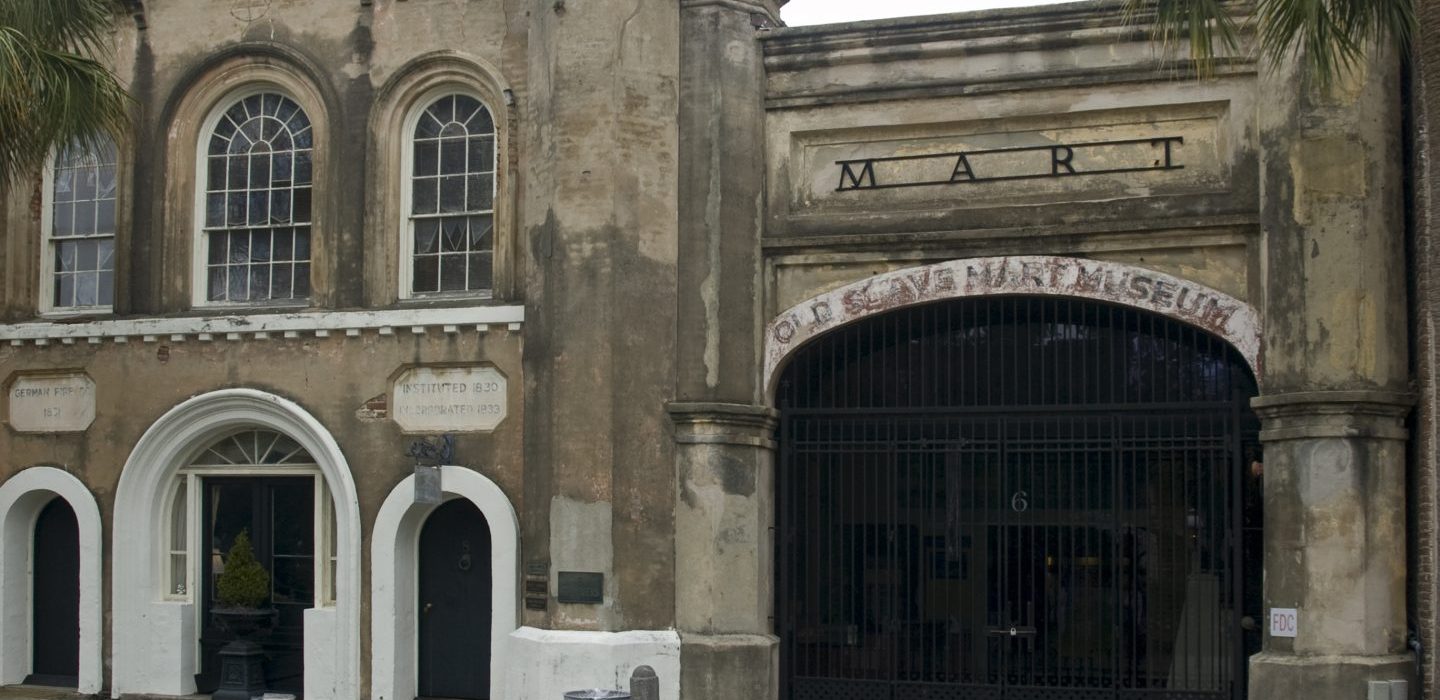Located at 6 Chalmers Street in Charleston, the Old Slave Mart Museum is said to be the only remaining structure utilized as an auction of enslaved persons of African descent in South Carolina. The building was originally part of a complex that contained a brick-gated yard; a kitchen; a four-story brick barracoon, or jail; and a dead house, or cemetery. The museum is dedicated in detailing Charleston’s involvement in the interstate slave trade of the United States from 1856 to 1863.
In 1807, a federal law prohibiting the importation of slaves into the United States was passed; it went into effect on March 3, 1808, the earliest date permitted by the Constitution. Because it stated that no new slaves were allowed to be brought into America, numerous states began to practice domestic trading. South Carolina would be one of those states and Charleston would be its leading city. It is in Charleston where Gadsden’s Wharf once stood, the disembarkation point of approximately 40% of all Blacks who would be enslaved in the United States.
From the creation of the U.S. Constitution in 1776 to the beginning of the Civil War in 1861, more than one million American-born Blacks would be enslaved in perpetuity for the purpose of developing, for free, the agrarian South. Industries, including rice, cotton, indigo and sugar, were dependent on the slavocracy that dominated American society. In Charleston, enslaved African Americans were sold in open marketplaces, most notably, in the area north of the Old Exchange building at Broad Street and East Bay Street. In 1856, a newly-passed ordinance outlawed public sales of enslaved persons of African descent in Charleston. Because of this prohibition, sales rooms, auction yards and marts, including Ryan’s Auction Mart, opened on Queen Street, State Street and Chalmers Street. Ryan’s Mart, was established by Thomas Ryan, a councilman of Charleston. Located between Queen and Chalmers Streets, it would become the Old Slave Mart in 1856. In addition to the selling of humans, the mart also sold livestock and real estate.
In 1863, the auctions of enslaved Blacks ended in Charleston. In 1865, the Union Army occupied Charleston; those enslaved persons who were imprisoned at the Old Slave Mart were freed and Ryan’s Mart was closed.
In the years following, the Old Slave Mart would be owned by different people and be used for various purposes, including as a tenement house for African-Americans and even as a shop for autos, purchases and repairs included. In 1938, as per the Charleston, SC Government website, Miriam B. Wilson “purchased the building and established a museum featuring African and African American arts and crafts.” Wilson, a native of Ohio, was the daughter of a decorated veteran of the Union Army. According to the article, “80 Years After First Opening, Charleston’s Old Slave Mart Museum Adds New Layers of History” written by Robert Behre for The Post and Courier, she bought “… the modest structure at 6 Chalmers St. because it was a surviving example of a mart where the slaves were sold domestically before the Civil War.” She ran the museum until she passed away in 1959.
Afterward, two sisters of Charleston, Judith Wragg Chase and Louise Wragg Graves took control of the Old Slave Mart Museum in 1964. Under their auspices, in 1973, the Old Slave Mart was placed on the National Register of Historic Places. However, the sisters closed the museum in 1987.
Because of its historic significance in African American culture as well as to local and national history, the City of Charleston acquired the site in 1988. By the late 1990s, the City of Charleston and the South Carolina African American Heritage Commisssion restored the Old Slave Mart. When the site opened in 2007, it would be as The Old Slave Mart Museum.
The site, approximately 2, 000 square feet, can be toured individually or as a small group. Because of its size, it can get congested quickly. It consists primarily of storyboards so be prepared to spend about ninety minutes there in order to gain the most from your visit. The museum recently acquired historic papers and images of the Old Slave Mart that provide authentic primary documentation essential in creating future exhibitions and engaging visitors.
Open Monday through Saturday, from 9am to 5pm, The Old Slave Mart Museum is recommended for older youth and adults. Also, there are materials, such as books, that may be purchased to learn more about African American culture as well as of Charleston history.
